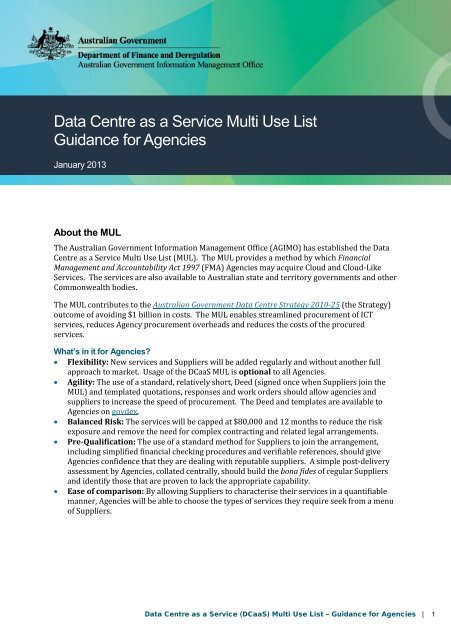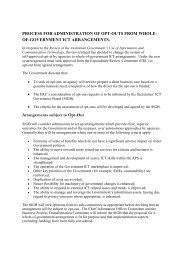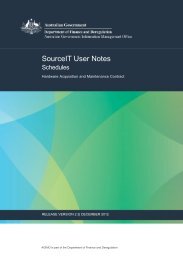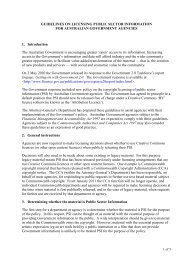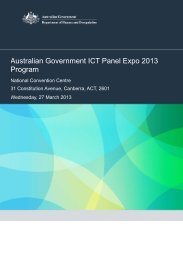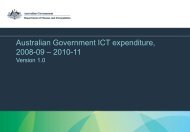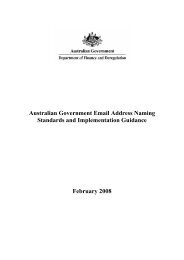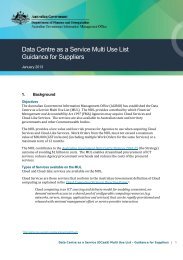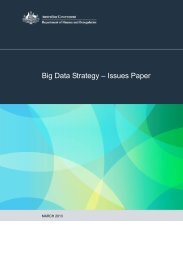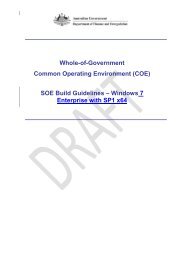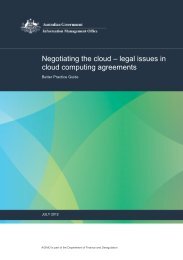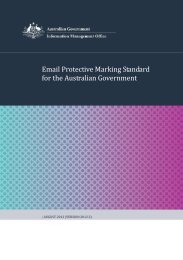Data Centre as a Service (DCaaS) Multi Use List - About AGIMO
Data Centre as a Service (DCaaS) Multi Use List - About AGIMO
Data Centre as a Service (DCaaS) Multi Use List - About AGIMO
- No tags were found...
You also want an ePaper? Increase the reach of your titles
YUMPU automatically turns print PDFs into web optimized ePapers that Google loves.
What the MUL won’t includeThe MUL will not include services that are mandatory for FMA Agencies to procure throughwhole-of-government ICT coordinated procurement arrangements, including, but not limited to:1. The <strong>Data</strong> <strong>Centre</strong> Facilities Panel2. The <strong>Data</strong> <strong>Centre</strong> Migration <strong>Service</strong>s Panel3. The Microsoft Volume Sourcing Arrangement (VSA)4. The Telecommunications Management PanelsThe MUL will not include services that are provided under the Gateway Reduction Program.Note: <strong>AGIMO</strong> may, in its sole discretion, remove services from the MUL that are mademandatory for FMA Agencies to procure through future whole-of-government ICT coordinatedprocurement arrangements or for which alternative arrangements are made by government inthe future.Cloud Computing for Australian Government AgenciesFor further information on the implications of, and considerations for, moving to the Cloudreview the following guides.• The <strong>AGIMO</strong> suite of Cloud Computing Guides includes:• Australian Government Cloud Computing Strategic Direction paper• Privacy and Cloud Computing for Australian Government Agencies• Negotiating the Cloud – Legal Issues in Cloud Computing Agreements• Financial Considerations for Government use of Cloud Computing• Community Cloud Governance – Better Practice Guide• Defence Signals Directorate's Cloud Computing Security ConsiderationsHow Suppliers are added to the MULOn 31 July 2012, <strong>AGIMO</strong> undertook an open approach to market to establish a MUL. Applicantswere invited to submit an Application for Inclusion (AFI), with the first round of approvedSuppliers published in October 2012.The approach to the market will be open until May 2014. During this time additional Suppliersmay join the MUL, further services may be added, and existing Suppliers may modify prices orservice descriptions.The process includes:1. Potential Suppliers log into AusTender and download the AFI documents and guides.2. Suppliers complete and submit the Head Agreement (Deed) and registration forms withinformation on their company, services and pricing.3. <strong>AGIMO</strong> <strong>as</strong>sesses the AFIs, <strong>as</strong> well <strong>as</strong> undertaking referee and financial viability checks onSuppliers.4. Successful Suppliers are added onto the <strong>Service</strong> Catalogue. This will be available through:• The <strong>AGIMO</strong> website: this version includes high level company details and servicedescriptions, but no pricing.• Govdex: The full <strong>Service</strong> Catalogue will be available through govdex to Agenciesonly. This will provide full contact details, service descriptions and pricing.<strong>Data</strong> <strong>Centre</strong> <strong>as</strong> a <strong>Service</strong> (<strong>DCaaS</strong>) <strong>Multi</strong> <strong>Use</strong> <strong>List</strong> – Guidance for Agencies | 3
Seeking services not available on the <strong>Service</strong> CatalogueAgencies may approach <strong>AGIMO</strong> proposing new services that could be provided through the MUL.If these proposed new services are within the scope of the MUL, <strong>AGIMO</strong> will publish a generalrequest on the <strong>AGIMO</strong> website and notify the Contact Officers of registered Suppliers. Suppliersor new Applicants may add these proposed new services to the <strong>Service</strong> Catalogue by submittinga new or amended AFI.The new services process enables Agencies to seek services that are not addressed in the <strong>Service</strong>Catalogue. The feature essentially works like a cl<strong>as</strong>sified advertisement. A description of theservice sought is published. Applicants and Suppliers may submit new or amended AFIs offeringthe new service. After successfully p<strong>as</strong>sing the <strong>as</strong>sessment process, the service will be added tothe <strong>Service</strong> Catalogue and interested agencies can initiate the quotation process.This process for addition of a new service to the <strong>Service</strong> Catalogue is likely to extend yourprocurement timelines.Lodging a new service request1. Log into the <strong>Data</strong> <strong>Centre</strong>s community on govdex. If you do not already have access togovdex, send an email to datacentres@finance.gov.au requesting access and confirming thatyou are an employee of the Commonwealth, state or territory government.2. Download the new service request template and draft a description of the new service youare seeking.3. Obtain approval in principal to approach the market from your Regulation 9 delegate.4. Send the new service description to datacentres@finance.gov.au.5. <strong>AGIMO</strong> will review the new service description:• to ensure that the service you are seeking is within the scope of the MUL; and• to <strong>as</strong>sess whether any Suppliers on the MUL already offer similar services.6. Once the <strong>Service</strong> Catalogue will be updated with the new services, <strong>AGIMO</strong> will advise you sothat you may seek quotations.<strong>Data</strong> <strong>Centre</strong> <strong>as</strong> a <strong>Service</strong> (<strong>DCaaS</strong>) <strong>Multi</strong> <strong>Use</strong> <strong>List</strong> – Guidance for Agencies | 7
Contract Management<strong>AGIMO</strong> is responsible for the Deed, which <strong>AGIMO</strong> will co-sign with the Supplier before theSupplier is added on to the MUL. <strong>AGIMO</strong> will also review any Work Orders created under aDeed, to ensure that the Supplier is meeting their requirements under the Deed.Agencies are responsible for the contract management of Work Orders signed under the Deed.The Agency will negotiate and agree to the terms of the Work Order, and manage the delivery ofservices by the Supplier.Varying a Work OrderSchedule 2 Contract Terms provides that the Contract will not be varied except by agreement inwriting signed by the Customer (Agency) and the Supplier. Either party may submit a requestfor variation in the form of the Change Proposal Form at Schedule 3 (Change Order Form). Toundertake a change request:1. Log into the <strong>Data</strong> <strong>Centre</strong>s community on govdex. If you do not already have access togovdex, send an email to datacentres@finance.gov.au requesting access and confirming thatyou are an employee of the Commonwealth, state or territory government.2. Download the Deed and review Clause 16 of Schedule 2 Contract Terms for the fullconditions for undertaking a variation.3. Negotiate the proposed changes with the Supplier.4. Complete Schedule 3 Change Order Form and provide to the Supplier for their agreement.5. Both parties must agree to and sign the variation.Dispute resolutionConsistent with Clause 12 of Schedule 2 Contract Terms, for any dispute arising under the Deed:1. the Parties will try to settle the dispute by negotiation;2. if unresolved, the party claiming that there is a dispute will give the other Party a noticesetting out the details of the dispute;3. within seven (7) days of the notice, each Party will nominate a senior representative, nothaving prior involvement in the dispute, to try to settle the dispute;4. failing settlement within a further 14 days, the Parties must refer the dispute to mediation orsome alternative dispute resolution procedure; and5. if the dispute or difference is not settled within 30 days of the submission to mediation orsome other form of alternative dispute resolution procedure (unless such period is extendedby agreement of the Parties), the Parties must submit it to arbitration in accordance with,and subject to, The Institute of Arbitrators & Mediators Australia Rules for the Conduct ofCommercial Arbitrations.Each Party will bear its own costs for dispute resolution. The parties to the dispute must equallypay the costs of any mediator or arbitrator.Despite the existence of a dispute, the Supplier must (unless requested by <strong>AGIMO</strong> not to do so)continue its performance under this Deed.The procedure for dispute resolution does not apply to action relating to termination or to legalproceedings for urgent interlocutory relief.TerminationClause 14 of Schedule 2 Contract Terms details the conditions for terminating an agreementwith a Supplier.<strong>Data</strong> <strong>Centre</strong> <strong>as</strong> a <strong>Service</strong> (<strong>DCaaS</strong>) <strong>Multi</strong> <strong>Use</strong> <strong>List</strong> – Guidance for Agencies | 8
Reporting on work undertakenAt the conclusion of each relevant Work Order, or otherwise <strong>as</strong> agreed with <strong>AGIMO</strong>, an Agencyshould <strong>as</strong>sess a Supplier’s performance. This is ‘For Official <strong>Use</strong> Only’ and will be shared withother Agencies on a confidential b<strong>as</strong>is. An Agency may at its discretion, provide a copy of thecompleted evaluation form to the Supplier.The feedback arrangements will not replace any process or arrangements that Agency andSupplier wish to use in order to deliver performance feedback. Any issues in relation to aSupplier’s performance evaluation should be resolved between the Agencies and Suppliers.The process1. Log into the <strong>Data</strong> <strong>Centre</strong>s page on govdex. If you do not already have access to govdex, sendan email to datacentres@finance.gov.au requesting access and confirming that you are anemployee of the Government.2. Download the Agency Feedback Template from govdex and fill out the contract details.3. Provide a rating against the performance criteria:a) quality of service;b) accuracy;c) responsiveness;d) understanding of Agency needs/requirements;e) professionalism and experience of Personnel working on the service; andf) value for money.4. Add any other comments or lessons learned.5. Send the completed form to datacentres@finance.gov.au.<strong>Data</strong> <strong>Centre</strong> <strong>as</strong> a <strong>Service</strong> (<strong>DCaaS</strong>) <strong>Multi</strong> <strong>Use</strong> <strong>List</strong> – Guidance for Agencies | 9
Appendix A: DefinitionsThe following definitions will apply to this Guidance for Agencies, in addition to those termswhich are defined in the body of this document:AFImeans the Application for Inclusion.AFI Closing Time 2pm, Australian Capital Territory Time, 29 May 2014.AFI ResponseAgency<strong>AGIMO</strong>ApplicantContractDeedFMA AgenciesSuppliermeans a response to the AFI.means any one or more of the following <strong>as</strong> the contextrequires:all agencies subject to the Financial Management andAccountability Act 1997 (Cth);all bodies subject to the Commonwealth Authoritiesand Companies Act 1997 (Cth);all other bodies governed by the Governor-General ora Minister of the Commonwealth or over which theCommonwealth exercises control;and all bodies governed by a State Governor or by aMinister of a State or Territory or over which a Stateor Territory exercises control (including departmentsin State or Territory Governments).the Australian Government Information ManagementOffice is a business group of the Department ofFinance and Deregulation.an entity or person who h<strong>as</strong> responded with an AFIResponse or, where the context requires, ispotentially responding with an AFI Response.means a contract formed pursuant to Clause 12 of theDeed.means the <strong>DCaaS</strong> MUL Head Agreement in the formincluded in the AFI. A copy of the Deed is on govdex.all agencies subject to the Financial Management andAccountability Act 1997 (Cth).an entity or person who h<strong>as</strong> entered into a Deed withthe Commonwealth.Work Order means a work order in the form set out in Schedule 1of the Deed.<strong>Data</strong> <strong>Centre</strong> <strong>as</strong> a <strong>Service</strong> (<strong>DCaaS</strong>) <strong>Multi</strong> <strong>Use</strong> <strong>List</strong> – Guidance for Agencies | 10


